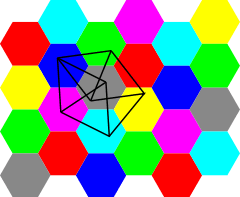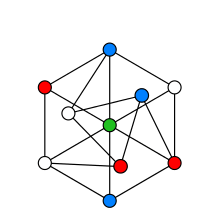Hadwiger–Nelson problem
| | Unsolved problem in mathematics: How many colors are needed to color the plane so that no two points at unit distance are the same color? (more unsolved problems in mathematics) |


In geometric graph theory, the Hadwiger–Nelson problem, named after Hugo Hadwiger and Edward Nelson, asks for the minimum number of colors required to color the plane such that no two points at distance 1 from each other have the same color. The answer is unknown, but has been narrowed down to one of the numbers 4, 5, 6 or 7. The correct value may actually depend on the choice of axioms for set theory.[1]
The question can be phrased in graph theoretic terms as follows. Let G be the unit distance graph of the plane: an infinite graph with all points of the plane as vertices and with an edge between two vertices if and only if the distance between the two points is 1. The Hadwiger–Nelson problem is to find the chromatic number of G. As a consequence, the problem is often called "finding the chromatic number of the plane". By the de Bruijn–Erdős theorem, a result of de Bruijn & Erdős (1951), the problem is equivalent (under the assumption of the axiom of choice) to that of finding the largest possible chromatic number of a finite unit distance graph.
According to Jensen & Toft (1995), the problem was first formulated by E. Nelson in 1950, and first published by Gardner (1960). Hadwiger (1945) had earlier published a related result, showing that any cover of the plane by five congruent closed sets contains a unit distance in one of the sets, and he also mentioned the problem in a later paper (Hadwiger 1961). Soifer (2008) discusses the problem and its history extensively.
Lower and upper bounds
The fact that the chromatic number of the plane must be at least four follows from the existence of a seven-vertex unit distance graph with chromatic number four, named the Moser spindle after its discovery in 1961 by the brothers William and Leo Moser. This graph consists of two unit equilateral triangles joined at a common vertex–x. Each of these triangles is joined along another edge to another equilateral triangle; the vertices y and z of these joined triangles are at unit distance from each other. If the plane could be three-colored, the coloring within the triangles would force y and z to both have the same color as x, but then, since y and z are at unit distance from each other, we would not have a proper coloring of the unit distance graph of the plane. Therefore, at least four colors are needed to color this graph and the plane containing it. An alternative lower bound in the form of a ten-vertex four-chromatic unit distance graph was discovered at around the same time by Solomon W. Golomb.[2]
The upper bound of seven on the chromatic number follows from the existence of a tessellation of the plane by regular hexagons, with diameter slightly less than one, that can be assigned seven colors in a repeating pattern to form a 7-coloring of the plane. According to Soifer (2008), this upper bound was first observed by John R. Isbell.
Variations of the problem
The problem can easily be extended to higher dimensions. In particular, finding the chromatic number of space usually refers to the 3-dimensional version. As with the version on the plane, the answer is not known, but has been shown to be at least 6 and at most 15.[3]
One can also consider colorings of the plane in which the sets of points of each color are restricted to sets of some particular type.[4] Such restrictions may cause the required number of colors to increase, as they prevent certain colorings from being considered acceptable. For instance, if all color classes are required to be Lebesgue measurable, it is known that at least five colors are required. In the Solovay model of set theory, all point sets are measurable, so this result implies that in this model the chromatic number of the plane is at least five. If a coloring of plane consists of regions bounded by Jordan curves, then at least six colors are required.[5]
See also
Notes
- ↑ Soifer (2008), pp. 557–563; Shelah & Soifer (2003).
- ↑ Soifer (2008), p. 19.
- ↑ Coulson (2002); Radoičić & Tóth (2003).
- ↑ See, e.g., Croft, Falconer & Guy (1991).
- ↑ Woodall (1973); see also Coulson (2004) for a different proof of a similar result.
References
- de Bruijn, N. G.; Erdős, P. (1951), "A colour problem for infinite graphs and a problem in the theory of relations", Nederl. Akad. Wetensch. Proc. Ser. A, 54: 371–373.
- Chilakamarri, K. B. (1993), "The unit-distance graph problem: a brief survey and some new results", Bull Inst. Combin. Appl., 8: 39–60.
- Chilakamarri, Kiran B.; Mahoney, Carolyn R. (1996), "Unit-distance graphs, graphs on the integer lattice and a Ramsey type result", Aequationes Mathematicae, 51 (1-2): 48–67, doi:10.1007/BF01831139, MR 1372782.
- Coulson, D. (2004), "On the chromatic number of plane tilings", J. Austral. Math. Soc., 77 (2): 191–196, doi:10.1017/S1446788700013574.
- Coulson, D. (2002), "A 15-colouring of 3-space omitting distance one", Discrete Math., 256: 83–90, doi:10.1016/S0012-365X(01)00183-2.
- Croft, Hallard T.; Falconer, Kenneth J.; Guy, Richard K. (1991), Unsolved Problems in Geometry, Springer-Verlag, Problem G10.
- Gardner, Martin (1960), "Mathematical Games", Scientific American, 203/4: 180.
- Hadwiger, Hugo (1945), "Überdeckung des euklidischen Raumes durch kongruente Mengen", Portugal. Math., 4: 238–242.
- Hadwiger, Hugo (1961), "Ungelöste Probleme No. 40", Elem. Math., 16: 103–104.
- Jensen, Tommy R.; Toft, Bjarne (1995), Graph Coloring Problems, Wiley-Interscience Series in Discrete Mathematics and Optimization, pp. 150–152.
- Radoičić, Radoš; Tóth, Géza (2003), "Note on the chromatic number of the space", Discrete and Computational Geometry: The Goodman–Pollack Festschrift (PDF), Algorithms and Combinatorics, 25, Berlin: Springer, pp. 695–698, doi:10.1007/978-3-642-55566-4_32, MR 2038498.
- Shelah, Saharon; Soifer, Alexander (2003), "Axiom of choice and chromatic number of the plane" (PDF), Journal of Combinatorial Theory, Series A, 103 (2): 387–391, doi:10.1016/S0097-3165(03)00102-X.
- Soifer, Alexander (2008), The Mathematical Coloring Book: Mathematics of Coloring and the Colorful Life of its Creators, New York: Springer, ISBN 978-0-387-74640-1,
- Woodall, D. R. (1973), "Distances realized by sets covering the plane", Journal of Combinatorial Theory, Series A, 14: 187–200, doi:10.1016/0097-3165(73)90020-4, MR 0310770
External links
- O'Rourke, Joseph. "Problem 57: Chromatic Number of the Plane". The Open Problems Project.
- Mohar, Bojan (2001). "The chromatic number of the Unit Distance Graph".